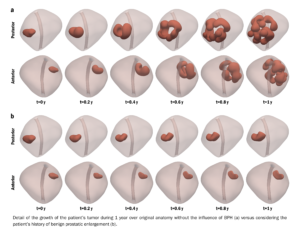- May 20, 2019
- Posted by: info
- Category: Research
Benign prostatic hyperplasia is a common pathology among aging men that induces the progressive enlargement of the prostate. Prostatic tumors originating in men with larger prostates tend to present more favorable pathological features, but the fundamental mechanisms that explain this interaction between benign prostatic hyperplasia and prostate cancer remain unknown nowadays.
This recent research conducted by Guillermo Lorenzo and Alessandro Reali, from CompMech, in collaboration with Hector Gomez and Pablo Dominguez-Frojan from Purdue University and Tom Hughes from the University of Texas at Austin (who received a Doctorate Honoris Causa from the University of Pavia), suggests a mechanical explanation for this phenomenon based on the idea that benign prostatic hyperplasia obstructs tumor growth by producing increasingly intense mechanical stresses in the prostate over time, which are known to slow down tumor dynamics.
This hypothesis is supported by an accurate qualitative simulation study based on isogeometric analysis and using a mathematical model that couples prostate cancer growth and the mechanical deformation of the prostate under benign prostatic hyperplasia and prostate cancer.
The results of this research have been published in the prestigious journal Proceedings of the National Academy of Sciences of the United States of America.
In the future, this type of simulations may also assist physicians in the clinical management of benign prostate hyperplasia and prostate cancer by predicting pathological outcomes and designing optimal therapies on a tissue-scale, patient-specific basis.


